Donna Smallin Kuper's Blog: The One-Minute Organizer Blog, page 5
August 21, 2019
How a Good “Why” Can Help You Say Goodbye to Stuff

This summer has been a season of change for us. We’re still loving the full-time RV life, which I like to refer to as minimalism on wheels. But we downsized even more and our lives are better for it. What it took was a good “why” to help us say goodbye to a few things that no longer served us.
It’s not always easy to let go, is it? Especially when it comes to hobbies you once enjoyed, things you keep because you paid a lot for them, and things you’re just used to having around. The truth is that holding on to things we no longer love or use (and maybe never did) dilutes our happiness in the present.
What I love about decluttering is that it helps us figure out what’s really important in our lives – not what was important yesterday or what might be important in the future, but what’s important today. Once we get clear about that, it’s easier to say goodbye to stuff and not look back. The following story about our recent downsizing includes some good reasons to let go of things that were keeping us stuck in the past.
When something you love creates more frustration than joy
When we sold our bricks-and-sticks home six years ago, I was taking piano lessons and wanted to keep playing. I couldn’t take my upright piano with us in the motor home, so I sold it and bought a portable keyboard, folding stand and chair.
I took lessons here and there for the first few years on the road. But with each passing year, I played less and less until I realized that I hadn’t touched the keyboard in well over a year. It was a hassle to set up the keyboard every time I wanted to play, only to have to put it away when I was done.
My piano keyboard literally did not FIT in my present life. Still, I was reluctant to say goodbye because I enjoy playing music. Then one day, I saw a man sitting on a picnic table in the RV park, playing a flute. And I thought to myself, “How wonderful that he can just pick up his instrument and play any time, anywhere.”
Long story short – I went to a local music store and traded in my keyboard for a clarinet. Now that’s an instrument that’s easy to travel with! So now, I have music back in my life and I don’t miss my keyboard at all.
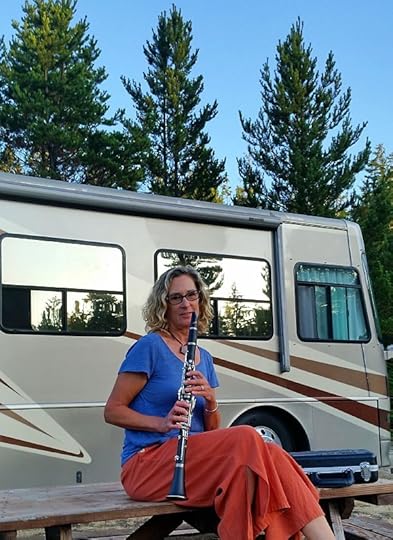 Now I can make music wherever I go!
Now I can make music wherever I go!When you’re allowing your life to be limited
The second thing my husband and I let go of this summer was our CanAm Spyder, a three-wheeled motorcycle that was our only vehicle (other than the motor home). It was fine, except when we rode two-up with me on the back. My knees got stiff after about half an hour, so we had to limit our excursions to shorter distances. Because of that, we sometimes missed out on seeing and doing things on our travels. And if it was cold or rainy? We were stuck at home.
I started dropping hints that maybe it was time to get a car. The challenge was that my husband wanted to keep the cargo trailer we tow behind our motor home. That meant finding a small, lightweight car that would fit into the trailer. Here’s what we ended up with…
 Our “new” car at the Oregon Coast
Our “new” car at the Oregon Coast We are now the happy owners of a 1972 MG Midget! Talk about a minimalistic car. It’s only about 5 feet wide and if I dangle my arm out the window, I can almost touch the ground. As much as I loved driving a motorcycle, I wasn’t at all that sad to say goodbye to the Spyder. We can still enjoy the thrill of an open ride, but now we have a more comfortable vehicle with an optional roof for inclement weather.
When you have more than you need
There was just one problem. Small as it is, the Midget is longer than the Spyder was. Somehow, we needed to create an additional two feet of space at the front of the cargo trailer. That was the good “why” I needed to let go of yet another well-loved thing from my past – my road bike.
I’ve had a lot of fun riding that bike all over the United States. Two years ago, I did a week-long bike tour across Iowa (RAGBRAI). This was an event that had been on my bucket list for 25 years. The following month, I rode 100 miles in one day, another bucket list item. But since then, I haven’t ridden my road bike more than 20 miles at a time. And I sometimes went months without riding it.
I also had what I called my “beater bike,” a cheap hybrid bike that I picked up at a garage sale last year. It was more suited for getting around the larger RV parks and for quick runs to the store. I got to thinking, “What if I could find one bike to replace my current two?”
My husband also had two bikes – a road bike he hadn’t ridden in years and a mountain bike. We agreed that that downsizing from four bikes to two would create the extra space we needed. So we went into a local bike store and ended up trading in both road bikes for a new hybrid bike for me. I added special clip-in pedals for fitness rides and a rear rack and panniers for getting groceries.
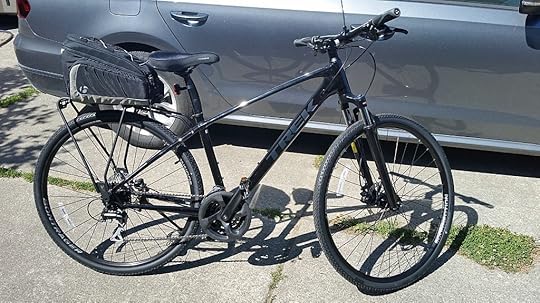
I figured I’d keep my road bike forever – that’s how I justified the cost when I bought it 13 years ago. But you know what? I got my money’s worth from it. I now have a bike that fits my present lifestyle better than my previous two bikes combined. And I had the pleasure of gifting my beater bike to a member of a local Buy Nothing group. She told me that she was the only one in her family without a bike. So now they can all go for rides together.
Bottom line…
Decluttering isn’t just about creating more space or having a tidier, more organized home. It’s a powerful tool that can help you dial in what you really want and need to be your best self at any stage of your life.
When we’re reluctant to let go of something, it’s usually for one of two reasons. Either it’s something we’ve been holding on to from our past or something we think we may need in the future. When we remember to focus on our present life, letting go gets easier.
Choosing to let go of the things we don’t want or need creates space for possibilities we may never have imagined. Ask yourself: Does this thing add value to my present life? Or does it subtract value? Use your answer to help you dig down to find the “why” that will help you say goodbye.
Photo (top) by Juli Moreira on Unsplash
The post How a Good “Why” Can Help You Say Goodbye to Stuff appeared first on Declutter Your Life with Donna Smallin Kuper.
July 26, 2019
Cleaning Your Garage – A Step-by-Step Plan
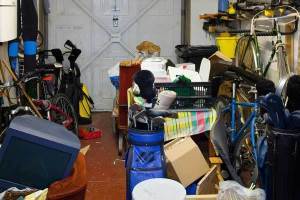 (This post was originally published on May 13, 2015 and updated on July 26, 2019).
(This post was originally published on May 13, 2015 and updated on July 26, 2019).
Did you know that 57% of people with two-car garages don’t have room to park cars inside them — or have room for only one vehicle? I think you know why. Because instead of getting rid of stuff, we throw it out in the garage!
If you’re ready to take on the challenge of cleaning your garage, now’s the time to get to it. With a few simple organization ideas, tidying up your garage and keeping it neat and clean is not only possible, it’s very doable. Here’s the plan…
Declutter first
Depending on the size of your garage and the amount of clutter, choose a full day or a full weekend to dedicate to decluttering and organizing your garage.
Make cleaning your garage a family project. Include family members, relatives or a few close friends. This will help speed up the process.
Go through every single item and sort into four piles – Keep, Donate, Sell, Toss.
A good tip for judging which items to let go of is to ask yourself one and only one question: Have I used this in the past year? If your answer is no, then it’s time to get rid of it.
Do not keep items that you think you may use someday. Wouldn’t you rather have the space those items are taking up…right now?
Having a hard time letting go of things you spent a lot of money on? The money has already been spent, so whether you keep the item (and never use it) or let it go, the money spent on it is not coming back. It’s best to just let go and make better spending decisions in the future.
Trash or recycle items you’ve decided to toss.
Pack up items to be donated in your car and drop them off at the nearest donation center.
Set aside items you plan to sell at an upcoming yard sale, online, or local consignment stores. If you are planning to have a yard sale, schedule it now.
Organize what’s left
Once that’s done and all of the clutter is out, it’s time to start organizing. First, figure out how much space your car(s) will take and then work with what’s left by placing items in spaces based on their types and uses:
Frequently Used: Keep items that you use frequently, such as shopping bags and pet leashes within easy reach – perhaps on hooks by the door.
Items Used Together: Create zones for groups of things such as auto care, gardening, and sports equipment so that like items are stored together.
Bulkier Items: Use the two back corners of the garage to store bulkier items such as a lawn mowers or snowthrower.
Rarely Used: Place rarely used items, such as holiday decorations or snow tires, on higher shelves of sturdy shelving units or consider installing a ceiling storage system. Just make sure your garage door doesn’t interfere with the ceiling storage.
Tools and Bicycles: Tools such as shovels and rakes and bicycles are best stored by hanging on the wall.
Note: If you’re using cardboard boxes as storage containers, you might want to seriously consider investing in some plastic bins that will keep insects and rodents from taking up residence in your house.
Keep it tidy
 Once you’re done with all of that, you’ll have a cleaner garage that is organized nicely. The next step is to make efforts year round to keep it that way.
Once you’re done with all of that, you’ll have a cleaner garage that is organized nicely. The next step is to make efforts year round to keep it that way.
Keep floor space as free as possible.
Spray for pests from time to time to keep insects at bay.
Sweep and hose down the floors regularly to get out dirt.
And the most important step of all: Repeat at least once a year to purge what’s no longer wanted or needed.
This article was submitted by Garaga, Canada’s leading garage door manufacturer.
The post Cleaning Your Garage – A Step-by-Step Plan appeared first on Declutter Your Life with Donna Smallin Kuper.
July 17, 2019
4 Ways to Organize Your Finances by Going Digital

Technology can really help us simplify our daily lives, especially when it comes to managing personal finances. For example, here are four ways going digital can help you organize your finances while saving you time, money, and stress.
1. Develop a Budget with Spreadsheets
Developing a personal or family budget is one of the most useful ways to organize your finances. By tracking your monthly income and expenses, you are able to know how much you’re spending and on what, and then use that to optimize your buying habits and save a lot of money in the long run.
Despite these advantages, only 4l% of Americans have a budget! This means that more than half of Americans are not keeping track of their finances.
Luckily for us, new technology has made the process of creating a budget easier than ever. Free online spreadsheets, such as Google Sheets, are easy to learn and there’s even a free budgeting template for you to use.
Once you’ve made a budget, you’ll quickly see where you can cut back. Then you can start looking for ways to put the money you’re now saving to good use such as establishing an emergency fund. Experts recommend that you save between 3-6 months of income in an emergency fund in case an unexpected life event or expense comes up.
Another valuable way to increase your savings is through the use of an expected expenses fund. This is a long-term savings account meant for expenses that you can reasonably expect to pay within 3-5 years, such as new home appliances, car maintenance, vacation, and medical expenses. By setting aside funds for expected expenses, you won’t be unprepared when you inevitably incur these costs.
2. Choose to Do Your Banking Online.
Before financial technology became as prevalent as it is today, purchases were made with checks or cash. This created a ton of paper clutter, including bank statements, bills, and cancelled checks.
New online bank accounts make it possible to bank on the go. This means you can have direct access to your finances at all times. You don’t need to set aside time to drive out to your bank to deposit checks and make transfers; now you can do it all from anywhere.
Online banking is a great way to organize your finances and better manage your money. It can even be used alongside budgeting apps to help you keep track of where you’re spending.
3. Organize Your Finances in Sync with Your Calendar.
Developing a personal schedule as part of financial planning may be confusing at first. Having a weekly or biweekly schedule planned out gives you the opportunity to prepare for expenses that may be incurred throughout the week.
There are a lot of great calendar apps out there, but most phones have one pre-built into them. Keep a running calendar with upcoming events. Include the cost associated with those events such as movie tickets, birthday gifts, or fuel costs to get you from point A to point B. Also note on your calendar upcoming pay days and bill due dates. This will help you prepare for expenses ahead of time, so you will never be left scrambling to find cash at the last minute.
Another great way calendars can be useful is for reducing expenses. For example, instead of making a special trip to the supermarket, you can plan to do it on your way home from an appointment to reduce fuel costs. Even better, plan to run all your errands at one time and map out the most efficient route.
4. Utilize Online Financial Calculators.
If you’re about to make a big purchase, one of the worst things you can do is go in blind. This is especially true for car and home purchases, due to their high cost and the frequent need to take out a loan on these expenses. Doing your research ahead of time lets you know exactly what your cost will be and can help you figure out what you can best afford with your budget.
Figuring out the costs isn’t easy though, especially if you aren’t someone with a lot of experience with math and finance. Not to mention that financial calculators can cost $100 or more! Thankfully, there’s now the option to turn to online financial calculators to help you easily calculate any payments you might need to make.
Not only are these calculators great for figuring out mortgage costs, but you can also determine the future value of your investments. This can be super beneficial when you’re deciding where to best allocate your retirement investments, and how much your 401k and Roth IRA will be returning.
To use a financial calculator online, you will need to know the meaning of five different variables:
FV = Future Value
PV = Present Value
PMT = Payment
N = Number of Periods
I = Interest Rate
Then, simply input the four variables you know into the calculator and have it solve for the unknown value! Most online calculators will have this information on their websites to help walk you through the calculations.
By budgeting and putting money aside for life’s extra expenses, you’ll stop worrying about where your next paycheck is going and start enjoying life more. What digital solutions have you found helpful to organize your finances?
Kristen is a content developer who frequently writes articles about topics in lifestyle and personal development. The primary focus of these articles is to provide her readers with insights on personal finance, staying organized, and living a happy life.
The post 4 Ways to Organize Your Finances by Going Digital appeared first on Declutter Your Life with Donna Smallin Kuper.
July 11, 2019
Self-Storage: Short-Term Solution? Or Long-Term Financial Drain?
 “Have you seen the show Hoarders?” As soon as someone finds out I’m a professional organizer, they ask this question.
“Have you seen the show Hoarders?” As soon as someone finds out I’m a professional organizer, they ask this question.
I believe one of the reasons people watch the show is they understand how clutter might get out of control, even if it’s not at that level now.
Compared to the rest of the world, many Americans could look like hoarders. We have garages filled with equipment we haven’t used in years with no room for cars. We have attics filled to the rafters with things we haven’t seen in ages. And we have basements filled with stuff we haven’t taken the time to go through for quite some time.
It’s a scary, fine line between a person with a hoarding disorder and “The Great American Consumer” with too much stuff.
The good, bad, and the ugly truth about self-storage units
Though the size of the American family has shrunk, the number of rented storage spaces has grown exponentially. According to U.S. self-storage industry statistics, storage construction spending increased from $241 million in 2011 to $5.27 billion in 2017; a 2,000% increase in six years! Many of these facilities have better security than most homes with climate-controlled units and electronic key gates.
Businesses use storage units to store inventory. Home sellers use them to store excess belongings while they stage their homes to sell. And people relocating across the country will often store belongings until a new home is purchased. All of the above are good reasons to rent a storage unit. Unfortunately, many storage units that were meant to be a short-term solution end up being a long-term drain on a family’s finances.
What to consider BEFORE you rent a self-storage unit
The tag line for one storage facility in my area is “Clean your house, Clear your mind, Store with us.” But cleaning your house doesn’t mean putting your stuff in another location where you could end up paying more money than the items are worth. Before renting a storage unit…
Set a deadline for your self-storage. Think of the storage as temporary and fluid, not permanent. Once it’s out of sight, it’s out of mind.
Make the tough decisions now. Going through stuff can be difficult, emotional, and exhausting. Are you delaying your decision-making about stuff? Bite the bullet and schedule time to get started. Consider asking a friend to help.
Could someone use stuff you have no use for? Before you decide to put stuff in storage, ask family and friends if they could use the item(s). Or consider selling items on Facebook Marketplace or with the LetGo app.
Calculate and understand the costs: figure it out for 3 months, 6 months and a year. How accessible are the units and will weather deter you from getting it cleaned out? Be careful not to let your storage unit go from a short-term convenience to a long-term burden. Paying money to store “stuff” is silly when you could probably use the money for…well, you fill in the blank!
 Vali Heist is a Certified Professional Organizer®, author, and self-proclaimed CRAP expert. Vali defines CRAP as Clutter that Robs Anyone of Pleasure. Her book, Organize This! Practical Tips, Green Ideas, and Ruminations about your CRAP, is available for Kindle and Nook readers. Vali’s goal is to share organizing solutions that help her readers and clients organize their best life at home and live in the CRAP-free zone.
Vali Heist is a Certified Professional Organizer®, author, and self-proclaimed CRAP expert. Vali defines CRAP as Clutter that Robs Anyone of Pleasure. Her book, Organize This! Practical Tips, Green Ideas, and Ruminations about your CRAP, is available for Kindle and Nook readers. Vali’s goal is to share organizing solutions that help her readers and clients organize their best life at home and live in the CRAP-free zone.
The post Self-Storage: Short-Term Solution? Or Long-Term Financial Drain? appeared first on Declutter Your Life with Donna Smallin Kuper.
July 6, 2019
3 Organizing Lessons from My Family to Yours
Are you familiar with the Gershwin tune, Summertime? As I sat down to share three organizing lessons, that song popped into my head. “Summertime, and the livin’ is easy” is the first line.
That’s how I’m feeling today – the livin’ is easy. We’re up in northern Washington visiting my oldest stepdaughter and her two girls. I love being here with them. And I love being here at this time of year. I’m enjoying pretty drives and bike rides and getting my fill of local strawberries, raspberries, and cherries. Yum.
Anyway, when we arrived, my stepdaughter had a lot of stuff in her garage that she wanted to donate. I checked the DonationTown web site to see if there are any charitable groups in the area that pick up donations. No luck.
Since she works a lot and I had time on my hands, I volunteered to take a carload to the local Goodwill store. What a popular place! I had to wait in a line of cars for about 10 minutes before it was my turn to unload my donations. I guess everyone has decluttering on their summertime to-do list!
Okay, here are the three organizing lessons I promised to share!
Organizing Lesson #1: Let other people clear out your garage for you.
Meanwhile, back in the garage, there were still quite a few things needing new homes. I requested to join the local Buy Nothing group on Facebook. As soon as I was accepted, I started posting photos of stuff, and within a week, almost all of it had been picked up by its new owners! My stepdaughter is thrilled it’s gone. Now she’s finding more things to offer to her neighbors.
If you haven’t heard of the Buy Nothing Project, you can read more about it here and see if there’s an active group in your area. What I love about the Buy Nothing community is that it gives you an easy way to re-home your things with another family who will love them. Not only do people gladly come get that stuff you no longer want, they thank you for it. It feels so good to give my old stuff a new life, it makes me want to see what else I can get rid of!
Organizing Lesson #2: The easier it is to put things away, the more likely you’ll do it.
A few days ago, my youngest granddaughter took me up on my offer to help her organize her room. We started with all the stuff (mostly clothing) scattered all over the floor. We grabbed a laundry basket and re-purposed it as a dirty clothes hamper. Then I discovered that her bedroom and bathroom were also lacking a place to toss trash. So we used a large gift bag that we pulled out of the “to recycle” pile as a temporary wastebasket and then later, found a real one.
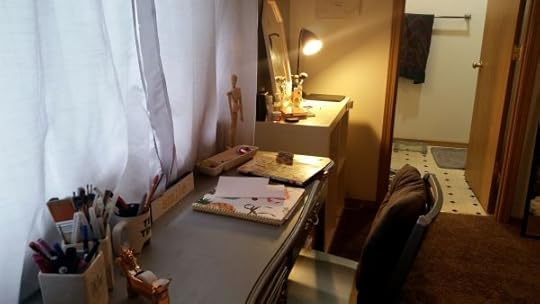
In the before photo I neglected to take, this desk was piled high with paper and other stuff.
Now, my granddaughter is lucky to have a big closet. But it had two heavy sliding doors that were difficult to open and close. And do you know what happens when it’s hard to put clean clothes away? It doesn’t happen. So we removed the doors and hung curtains on a tension rod. Now she can easily access her dresser drawers and hanging clothes just by moving a curtain.
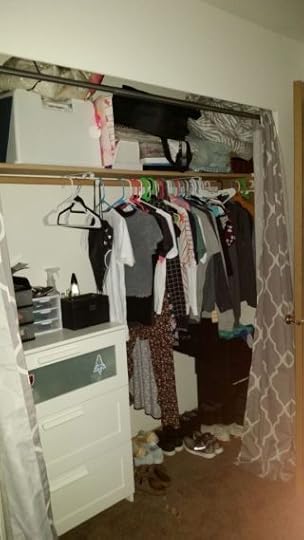
Sometimes curtains are a better choice than doors for a bedroom closet.
Her sock drawer was so full that there wasn’t room for another pair of socks. And you know what happens when it’s too hard to put things away, right? Right. We dumped out all the socks on the floor and sorted by color to make it easier to match. Then we tossed the keepers back up into the drawer. As we sorted, we tossed socks that were too small and socks she didn’t like into a donation bag. Turns out she had a lot of socks missing mates. We tossed them, too.
By the time we were done cleaning her room, we had one big bag of clothing, another bag with miscellaneous stuff to give away, and a third bag of paper trash. She really got on a roll toward the end! In fact, I could see that she was actually very good at organizing. What she needed was someone to help her tackle what I’m sure felt like an overwhelming job. The hardest part of getting organized is often just getting started.
Organizing Lesson #3: You need to get good at showing your clutter who’s the boss.
Will my granddaughter be able to keep her room clean now? Time will tell. From what I understand, she’s organized her room many times before only to have go through the whole process of organizing again. (I’m sure that’s never happened to you, my dear reader – wink, wink.) I’m hoping that having a home for dirty clothes and garbage will keep stuff off the floor, which will at least make her room look cleaner.
What we sometimes forget is that decluttering is not a one-and-done kind of project. You do it. And then at some point, you need to do it again. How often depends on your level of comfort with clutter. Personally, I prefer to declutter more often because it’s a lot easier to keep up than it is to catch up.
One thing I do to keep clutter at bay is follow the One-In, One-Out rule. For example, when my stepdaughter cleaned her closets. I became the lucky recipient of three pair of jeans in different colors, plus some tops she no longer wanted. Looking at what I already had in my closet, I decided to replace three older pair of jeans with the three new pair of jeans. Then I pulled out several tops I’d been holding on to for some unknown reason and added them to the donation bag.
Another way to show clutter who’s boss is to pay attention to what you bring into your home, whether it’s a grocery store flyer or something you bought on impulse because it was on sale. Ask yourself: Do I really have a need for this? We need much less than we think we do. And when we have only what we really need, there’s no clutter!
Are you ready to declare your independence from clutter? If you don’t know where to start or you need a plan you can follow, consider signing up for the summer edition of Uncluttered. Registration just opened for this online decluttering course that I’ve dubbed “the best decluttering course I never created!” I even have a Friends & Family discount for you – enter the code FF25 to save 25% off the already low registration fee.
The sooner you kick clutter to the curb, the sooner you, too, can be singing “Summertime…and the livin’ is easy.”
Do you have any summer organizing lessons to share? Something you’ve learned the hard way or wish you had known way back when? Do tell!
The post 3 Organizing Lessons from My Family to Yours appeared first on Declutter Your Life with Donna Smallin Kuper.
June 12, 2019
9 Tricks for Keeping Your Carpets Clean Like the Pros
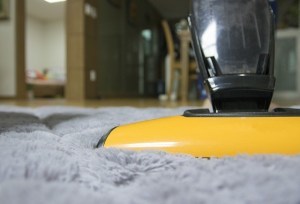 Keeping your carpets clean can be a lot of work. Your carpets go through a lot on a daily basis. If you have pets or kids, the abuse your carpets can take increases exponentially.
Keeping your carpets clean can be a lot of work. Your carpets go through a lot on a daily basis. If you have pets or kids, the abuse your carpets can take increases exponentially.
Even if you don’t have to worry about messes made by pets or kids, you’ve still probably had at least one moment of panic when a spill caused a stain you weren’t sure how to get out.
When in doubt, try these tricks for keeping your carpets clean from professionals who clean carpets for a living.
1. Blot, Don’t Scrub
When it comes to stain removal, this is a key tip. Make sure you are blotting at stains as you remove them. This lifts the liquid you’ve spilled out of the carpet fibers. Scrubbing will push any liquid or dirt deeper into the carpet making the stain set into the carpet instead of lifting out – and you run the risk of permanently damaging carpet fibers. One more thing: be sure to blot from the outside of the stain inward to avoid spreading the stain.
2. Try Shaving Cream to Remove Stains
If you have some stains that are set in, shaving cream may be the way to go to get those stubborn stains out. Apply the shaving cream directly to the stain and let it sit for about 30 minutes. You’ll want to make sure to blot it up, and then for good measure follow it up with a mix of 1 teaspoon of white vinegar mixed with 1 cup water, sprayed and blotted up with a clean cloth.
3. Freeze Gum to Get It Out
The pros have special sprays that will freeze gum so it hardens up and can be quickly scraped out of a carpet. You can do the same thing with ice cubes. Freeze the gum using some ice from your freezer. Once the gum is hardened as much as possible, use a spoon to lift up the hardened wad of gum.
Snip any fibers that won’t loosen as close to the piece of gum as possible. If you only have to snip a few fibers and they’re as minimally clipped as you can manage, you shouldn’t be able to notice any difference after you’ve finished the job.
4. Dish Detergent for Grease Stains
Grease stains in your carpet can be especially hard to get out. Maybe you’ve given up ever getting them out at all. Before you write it off entirely, give liquid dish detergent a try. With its grease-cutting properties, it might just do the trick for removing grease stains.
Mix a drop or two of dish soap in a spray bottle with about a cup of water. Shake it up, then spray the liquid directly on the grease stain. Let it soak in for a few minutes before you start blotting it up. If the stain is particularly stubborn, you may have to do this a few times before you see full results, so don’t give up right away. Finish up by spraying the carpet with warm water and blotting with a clean cloth to “rinse” detergent residue.
5. Baking Soda Will Freshen Things Up
If your carpets need to smell a little fresher than they do right now, skip the store-bought carpet fresheners. Baking soda is a great solution for deodorizing carpets because it naturally absorbs odors, even strong odors from pets and cigarette smoke. Simply sprinkle baking soda over your carpets and rugs, allow to sit overnight, then vacuum it up.
6. Use a Squeegee to Lift Pet Hair
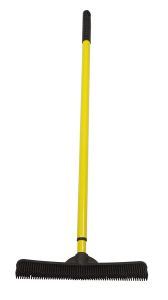 So this tip does have a limitation. If your carpet is a longer shag carpet style, this method of pet hair removal probably isn’t going to do much for you. But if you have a shorter length carpet, a squeegee will be your new best friend. Scrape it across the surface of your carpet to see instant results that a vacuum just isn’t going to deliver.
So this tip does have a limitation. If your carpet is a longer shag carpet style, this method of pet hair removal probably isn’t going to do much for you. But if you have a shorter length carpet, a squeegee will be your new best friend. Scrape it across the surface of your carpet to see instant results that a vacuum just isn’t going to deliver.
If you how that works, consider investing in a squeegee made for this job. The Evriholder FURemover Broom with Squeegee has soft rubber bristles than can dig deep into your carpet’s fibers to pick up loose fur that a regular flat head squeegee can’t – without damaging the carpet or rug.
7. Use an Iron to Remove Stains
This is a good trick for spot treating a stained area of your carpet. First, you’ll want to vacuum up the area to make sure all the dirt is removed. Then mix a solution of 3 parts vinegar to 1 part water and spray that on the stain. Allow it to soak in, then place a towel over the stain and a warm iron on top of the towel. The heat will pull the vinegar solution and the stain out of the carpet. Repeat a few times if you need to for stubborn stain areas. Be sure not to touch the iron directly to the carpet to avoid scorching.
8. Use a Lint Roller to Quick Clean Small Area Rugs
If you have a small area rug that always seems to look a little dusty and dirty no matter how often you vacuum, try a lint roller. Much like the squeegee for the pet hair, a lint roller will give you some great instant results. You’ll still want to vacuum regularly, but the lint roller is something you can grab when you need a quick clean.
9. Remove Wax from Carpet with Heat
If you love candles, you’ve probably had wax drip on your carpet at least once. It tends to be just as frustrating to get out as gum can be, but the solution is the exact opposite. To get the wax out, heat it back up. Place a towel over the wax and use a hot iron to heat the wax under the towel. After 30 seconds lift the iron and scrape away the wax with a butter knife or credit card.
With luck, you won’t need all of these carpet cleaning tricks, but stains happen and knowing what to do is the first step to keeping your carpets as clean as possible. You’ll still want to have them professionally cleaned every 12-18 months, but with these tips, you may be able to space out the time between professional cleanings and still have carpets that look fantastic.
 Guest blogger Gabe Nelson is a content specialist, currently working for Msscleaning, an IICRC-certified firm offering residential and commercial carpet cleaning services in the Denver, Colorado area.
Guest blogger Gabe Nelson is a content specialist, currently working for Msscleaning, an IICRC-certified firm offering residential and commercial carpet cleaning services in the Denver, Colorado area.
The post 9 Tricks for Keeping Your Carpets Clean Like the Pros appeared first on Declutter Your Life with Donna Smallin Kuper.
June 5, 2019
Late Spring Cleaning Tips
Spring sure has taken its time coming this year. The good news is that if you haven’t finished (or even started) your spring cleaning, it’s not too late to get to it with these late spring cleaning tips.
11 Tips for Faster, Easier Spring Cleaning
My late spring cleaning tips will help you get your home in tip-top shape fast – so you can get out there and enjoy the beautiful weather now that it’s finally here.
Zoom, zoom. Remove clutter from floors, coffee tables, and other horizontal surfaces before you start cleaning so you can zoom through each room. A quick way to do this is to collect everything in a laundry basket to be put away when you finish cleaning.
Skip it. Spot clean visible dirt and smudges – skip cleaning entire walls, inside windows, hardwood floors if they look okay. What I love for spot cleaning scuff marks on baseboards and removing crayon and grease from painted walls – Mr. Clean Magic Eraser. The “magic” is actually a melamine foam that works like fine sandpaper to lightly sand away grime. Always, always test it on an inconspicuous place first.
Call in the pros. Consider hiring out carpet, window and screen cleaning. Pros do it faster, better and for less than you might think. A few years ago, I had all of the windows in a two-story house cleaned inside and out for $125 and that included cleaning the screens! They were done in less than two hours and it was worth every penny.
Start high. Remove cobwebs from ceiling fans and corners, door and window moldings, and lighting fixtures with a long-handled duster or broom. Now would be a good time to remove and clean those lighting fixtures if you can see insects in there. While you’re at it, give (cool) light bulbs a wipe to remove grime. FACT: A dirty light bulb emits 20% less light than a clean one.
Believe in miracles. Wet a microfiber cloth and wring it out completely – or spritz it with water. Use to wipe all mirrors and glass surfaces for a streak-free clean. I use microfiber cloths designed specifically for glass for that job. For larger jobs like kitchen and bathroom, I use larger microfiber cloths to get the job done quicker. Use different color cloths for bathroom and kitchen to avoid introducing germs from one room to the other. Microfiber cloths are also my choice for dusting and cleaning everything from computers and cell phones to window blinds and chair legs.
Walk away. When it comes to cleaning the shower/tub, bathroom sinks and toilet, let cleaning products do the hard work for you. Spray cleaning product and let sit for 5-10 minutes to loosen soils. To clean a dirty microwave, set a microwaveable bowl of water in your oven and heat on high for 5 minutes. The steam produced will soften hardened-on gunk, making it easier to wipe clean.
Follow the one-tool rule. Grab what you need to tackle a specific cleaning project throughout a room or even your entire home. Done? Put that tool away. Grab the next. So, for example, do all of your dusting, then all of your wet cleaning chores (think kitchen and bath), and then finish up by vacuuming.
Clean while you sleep. Wouldn’t it be wonderful to wake up to a clean house? You can – sort of. Before going to bed, set your oven to self-clean. Pour toilet cleaner in toilet bowls, then just brush and flush in the morning.
Get moving. Move furniture and large appliances so you can vacuum underneath and behind. Roll up large area rugs and vacuum underneath. Don’t forget to get after those dust bunnies under your bed! Those “critters” only sound cute – they’re actually made up of a mixture of tiny fibers shed from feathers and fabrics, pet dander, food particles, bacteria, mold and fungus spores, and insect parts. Dust bunnies also contain dust mites, the microscopic creatures that feed on dust and their waste products. Yuck.
Give me 30. If you want to dedicated an entire day or weekend to your spring cleaning, go for it. Otherwise, plan to clean for just 30 minutes a day until the job’s done.
Reward yourself. Treat yourself to fresh flowers for your table, a massage or pedicure, or dinner at your favorite restaurant when you’ve spring cleaned your home to your satisfaction.
If you already finished your spring cleaning, congratulations! Maybe it’s time to tackle the garage!
The post Late Spring Cleaning Tips appeared first on Declutter Your Life with Donna Smallin Kuper.
May 23, 2019
A Guide to Helping Your Aging Parents Downsize
 There may come a time when your aging parents’ home becomes too large or difficult for them to manage, and it makes sense to downsize.
There may come a time when your aging parents’ home becomes too large or difficult for them to manage, and it makes sense to downsize.
That might mean your parents moving in with you, moving into assisted living, or just moving into a smaller home or apartment.
Making the decision to downsize is tough, but can be very beneficial in the long run. Here’s how you can help your loved ones make a smooth transition to their new home.
Preparing for the Move
Before your family member moves, everyone involved needs to know what to expect. Communication is key throughout this process. Make sure to discuss the time frame of the move with your loved ones. They should know when to start packing, how long they have until moving day, and who will be assisting with the process. This will help avoid confusion.
Keep in mind:
A downsize of this caliber is going to require the ability to delegate and organize your loved ones’ items.
Moving can cause a lot of stress on your loved ones – they may be reluctant at first or along the way.
Your attitude towards the transition can have a big impact on how easy or difficult the moving process will be.
Set Firm Dates
Create a calendar to outline all the aspects of this move to ensure that everyone is on the same page. Make sure to block out time for:
Decluttering, organizing and downsizing
Donation drop-offs, holding a garage or estate sale, and/or junk removal
Packing
Renting a moving truck or hiring a professional mover
Moving day
Unpacking boxes and setting up the new place
Decluttering and Organizing
Downsizing is no small task, and doing too much at once can be overwhelming. Make sure to take it slow, and give your family members plenty of time to make things easier on them. Remember that your loved ones’ participation in this process can help them feel in control, which can minimize anxiety and calm their nervousness about the big move.
Try to keep packing, sorting and organizing confined to less than a couple of hours per day, and make it a sociable experience. If your parent wants to stop and reminisce, join in; it will make the transition more enjoyable for them.
If the person who is moving has a lot of things (furniture, keepsakes, etc.) that can’t come along, there are decisions to make. These decisions should be made by your loved ones – after all, it’s their belongings in question, not yours (think about how you’d feel if someone suddenly took the reins and dictated what was going to happen to your stuff!).
Together, you can categorize each item and put them in separate piles to sell, donate, or give to family or friends. While putting your loved one’s things in a storage unit may seem like a great option, especially if they are hesitant about parting with their belongings, this should be avoided as it just delays the decision-making.
Float the idea of having your loved ones invite family members and friends over to look at their belongings and put their name on anything they would like to keep. This can help take the pressure off having to get rid of items that have brought them joy in the past. You can also have their adult children claim their own (but only their own!) keepsakes during the process. Old sports trophies, high school yearbooks, and other items can go home with their owners to make things easier for everyone.
Keep all important paperwork like birth certificates, deeds, financial documents, medical records, passports, wills, and powers of attorney in a central location, like a safe deposit box. Let key family members know where they are and how to access them.
If you run into conflicts or feel you need help at any point in the process, consider hiring a professional organizer or senior move manager. The pros know how to declutter efficiently, and are usually experienced at mediating any conflict and working through issues that may arise over possessions.
Packing and Unpacking
Once you have packed everything into boxes for the move, label all boxes with the room they will be moved to at their destination. Also note the general category of contents such as bedding, bath towels, or dishware. For those things you may need right away such as a box cutter, toilet paper, coffee and coffee maker(!), pack a box labeled “Open First” or take it with you in your car.
In addition to helping your loved ones to declutter and pack, offer them assistance in unpacking and setting up their new home. Make it a fun and enjoyable experience to give their new place a warm and loving welcome. Be sure to check in on your loved one regularly in the months after the move, to see how they are adjusting to their new home.
Whether your loved one is moving to Phoenix, AZ, Orlando, FL, or somewhere else entirely, adjusting to life in a new place can be challenging. It involves big changes, like leaving behind a home and all the memories it contains, as well as the feeling of losing a measure of freedom.
You can support your loved one by being there for them during this time and helping them plan, organize, and settle in to their new home. Following these tips will ensure you and your loved ones are able to make the transition as painless as possible.
Jennifer Karami is a writer at Redfin, a technology-enabled real estate brokerage. With a 1% listing fee and full-service agents, Redfin’s mission is to redefine real estate in the customer’s favor.
The post A Guide to Helping Your Aging Parents Downsize appeared first on Declutter Your Life with Donna Smallin Kuper.
May 14, 2019
The Gift of Organizing Your Life and Legacy Affairs

Photo by Annie Theby on Unsplash
We talk a lot about the benefits of organized spaces, but have you given much thought to organizing your life and legacy affairs?
In an emergency, the last thing you or a loved one should be doing is trying to find paperwork. Sadly, this is often the case because our health insurance details, medical information, and advance directives are incomplete, scattered, or non-existent. Or we’re the only ones who know where to find those documents.
And medical and health documents aren’t the only important documents to think about. What about your will and/or estate plans, financial and insurance information, property and business interests? And don’t forget your digital life – sharing passwords is the key to ensuring that your digital information and accounts can be accessed by trusted parties.
Make a Plan for the Inevitable – and the Unexpected
Taking inventory of what documents you have and where they are located can save you and your loved ones a great deal of time, money, and stress in an already stressful situation. Making a plan for both the inevitable as well as the unexpected is a huge gift to your family – and peace of mind for you.
Though it may not seem urgent, this is one of those organizing projects that’s important to complete sooner rather than later. Now, when you’re not in an emergency situation, is the time to think through details and priorities. And the time for end-of-life planning is not something you can keep putting off, because there will come a time when it’s too late.
Why Sooner is Better than Later for Getting Your Affairs in Order
Here are a few statistics that highlight the importance of organizing and planning your life and legacy affairs:
90% of people say that talking with their loved ones about end-of-life care is important, yet 27% have actually done so. (The Conversation Project National Survey, 2013)
The amount of unclaimed life insurance payouts was over $1 billion. (Consumer Reports, 2013)
Less than half of U.S. adults (42%) currently have estate planning documents such as a will or living trust (Caring.com 2017 survey)
Whether you’re married or single, have children or not, are working or retired, healthy or ill, now is the time to get your affairs in order. Start by gathering important documents and information and keeping them all together in one place. Be sure to share the location of these documents with one or more family members who can access them if you are unable.
A Tool That Makes it Easy to Organize Important Information
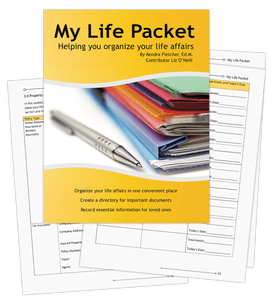 As a member of the organizing industry, I’m often among the first to learn about tools to simplify and declutter our lives. Recently, Liz O’Neill, one of my esteemed colleagues, introduced me to My Life Packet, an organizational tool that walks you through what you need to collect, record, and share to get your life and legacy affairs in order.
As a member of the organizing industry, I’m often among the first to learn about tools to simplify and declutter our lives. Recently, Liz O’Neill, one of my esteemed colleagues, introduced me to My Life Packet, an organizational tool that walks you through what you need to collect, record, and share to get your life and legacy affairs in order.
My Life Packet makes it easy to document and organize your critical information including financial documents, legal documents, titles and deeds, digital world, and end-of-life planning. It’s available in two formats: a 3-ring binder and a digital format.
Plus, if you want expert assistance, you can opt for a My Life Packet Package that includes a 90-minute assessment and action plan session plus one or more follow-up video or phone calls with Liz, both versions of My Life Packet, and more.
And, whatever version of My Life Packet you choose, Liz is offering a 10% discount just for you – simply enter the coupon code UNCLUTTER at checkout.
Do Something Today Toward Your Goal of Organizing Your Life
If you do nothing else, I encourage you to take a moment right now to visit the My Life Packet web site to learn more about this simple system for getting your affairs in order. Pricing starts at just $27 (with your discount) – a small price to pay for a tool that not only helps you organize your life and legacy, but also provides peace of mind for you and your family.
The post The Gift of Organizing Your Life and Legacy Affairs appeared first on Declutter Your Life with Donna Smallin Kuper.
April 26, 2019
5 Pro Moving Tips: How to Save Time, Money, And Stress
 The sunny weather of late spring may make many think of the upcoming summer days and how many times they can make it to the beach this year. But it’s also the season for packing up all of their worldly belongings and settling into a new home.
The sunny weather of late spring may make many think of the upcoming summer days and how many times they can make it to the beach this year. But it’s also the season for packing up all of their worldly belongings and settling into a new home.
About 43 million Americans move to a new apartment or home every year. If you’re among those millions this year, take a deep breath and release all of your stress about your impending move. Use these tips to successfully work with a professional moving company and save yourself the time, money, and stress of doing it yourself.
Ask About Discounts
The costs of moving from one home to another add up quickly. If you’re a member of AARP, AAA, or a similar group, check to see if you get any discounts for working with certain companies. These groups will often partner with moving companies, truck rental companies, and other moving service providers to help you save money on your move.
Do Some Digging
Moving families are typically under a lot of stress, making them targets for any companies with bad intentions. Before you sign a contract with a moving service, check online resources to ensure that they have the proper licenses.
For state-to-state moves, a company must register with the Federal Motor Carrier Safety Administration. You can check this agency’s website to see if your moving company is registered and if customers have made complaints against it. The company should have a local license as well that you can check against state agencies. You can also check to see if a company is certified by the American Moving & Storage Association, as well as how their reviews look on sites like Yelp and Angie’s List.
Nail Down Your Insurance
While every moving company is required to assume liability for the goods they are transporting, there are two main levels of liability from which you can choose. The most comprehensive plan is the Full (Replacement) Value Protection. Under this plan, your mover has two options whenever an item is lost, destroyed, or damaged while in their custody. The mover can either repair the item to restore it to the same condition it was in before they received it, or replace the item with another of like kind and quality. A mover is allowed to limit this protection to apply to only articles of extraordinary value, which is any item whose value exceeds $100 per pound. Be sure to ask for a complete explanation of this limitation before agreeing to this insurance.
The most economical insurance plan is Released Value Protection. Moving companies typically offer this plan at no additional cost, but it has minimal protection. With this plan, your mover is only liable for up to 60 cents per pound, per article. You can also purchase moving insurance from a third-party company and your homeowner’s insurance may already cover liability for moving.
Arrange A Home Visit Before Hiring A Mover
When you’re trying to choose the right mover, you’re going to want estimates from each company in the running. To get the most accurate estimate you should have the mover visit your home. This will allow the mover to review everything that you’re moving so that they can provide the most accurate estimate possible. Before the movers give you a quote, you can also give them a household inventory list that details all of the items they’ll be moving. This allows them to see it all on one concise document and helps you keep track of what you need to entrust to the movers.
Ask About Fees
Before you get your final moving bill, be sure to ask your moving company about what kind of extra fees they charge. Many companies will charge extra for moving things up and down stairs or packing fees for items that are not properly packed. They may even charge if there is not a close parking space for the moving truck. Save yourself these extra charges and the stress of having to pay unexpected fees by asking the moving company about every single fee they charge.
Moving companies are meant to simplify a move, but choosing the right one is an intricate process in itself. Be sure to cover all of your bases by asking the right questions and doing your own research. You’ll soon find a moving company you love and they’ll have you peacefully settled in your new home before you know it.
 J.H. Craig started a commodities hauling business in 1918, hauling cattle, feed, and hay from the rural farms of Virginia to the urban markets of the DC area. In the 1940s, the area started evolving from farmland to residential communities. We had to change with the times, so we began moving people into their homes after hours and in our spare time. Our great-grandfather, Dick and his brothers Earl, Jim, and Bob decided to go full time. Still family-owned and operated, we provide quality moving services across the US – from Maine to Florida and as far west as the Mississippi River. Allow us to handle your next move.
J.H. Craig started a commodities hauling business in 1918, hauling cattle, feed, and hay from the rural farms of Virginia to the urban markets of the DC area. In the 1940s, the area started evolving from farmland to residential communities. We had to change with the times, so we began moving people into their homes after hours and in our spare time. Our great-grandfather, Dick and his brothers Earl, Jim, and Bob decided to go full time. Still family-owned and operated, we provide quality moving services across the US – from Maine to Florida and as far west as the Mississippi River. Allow us to handle your next move.
The post 5 Pro Moving Tips: How to Save Time, Money, And Stress appeared first on Declutter Your Life with Donna Smallin Kuper.
The One-Minute Organizer Blog
- Donna Smallin Kuper's profile
- 45 followers







